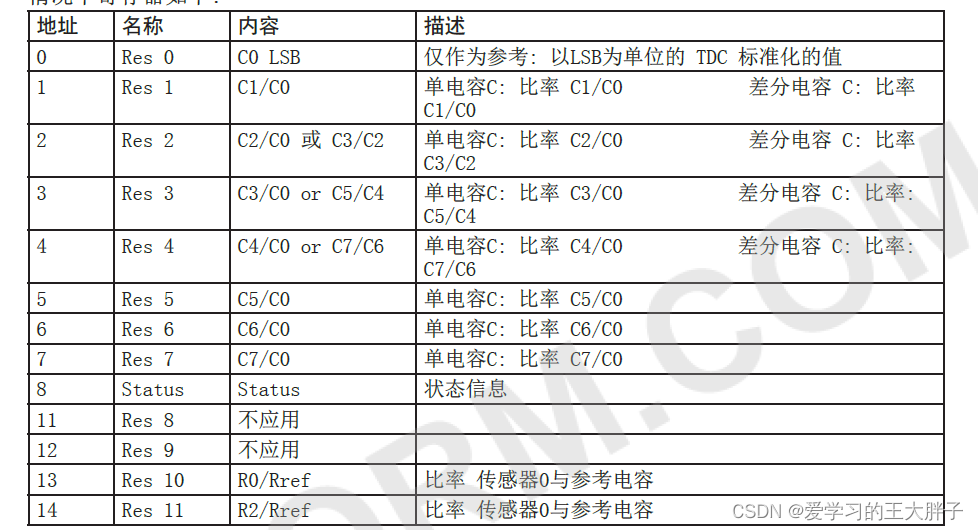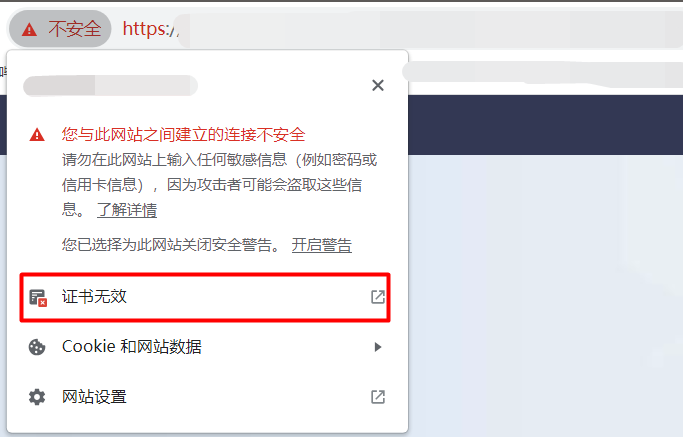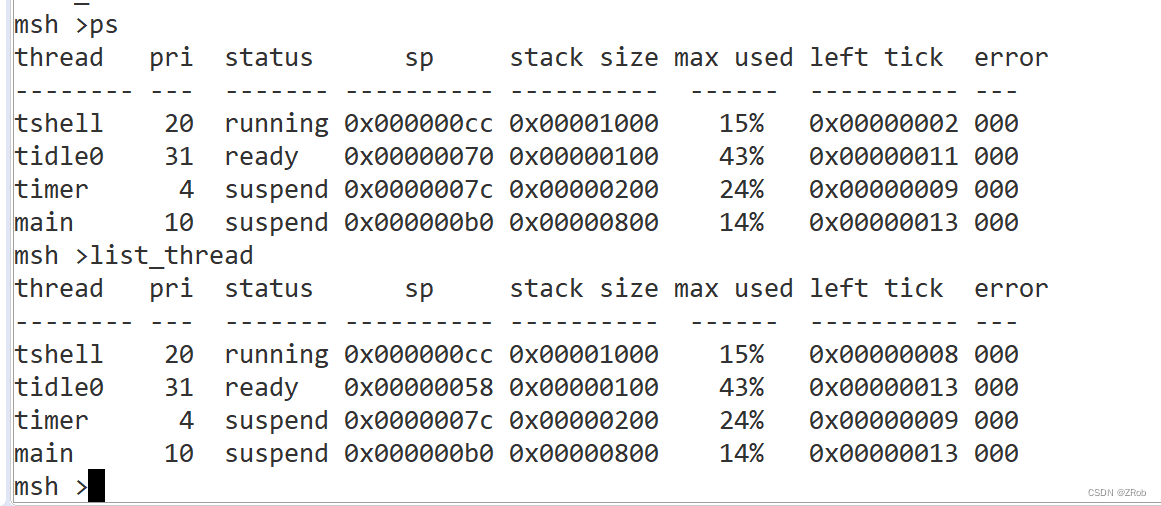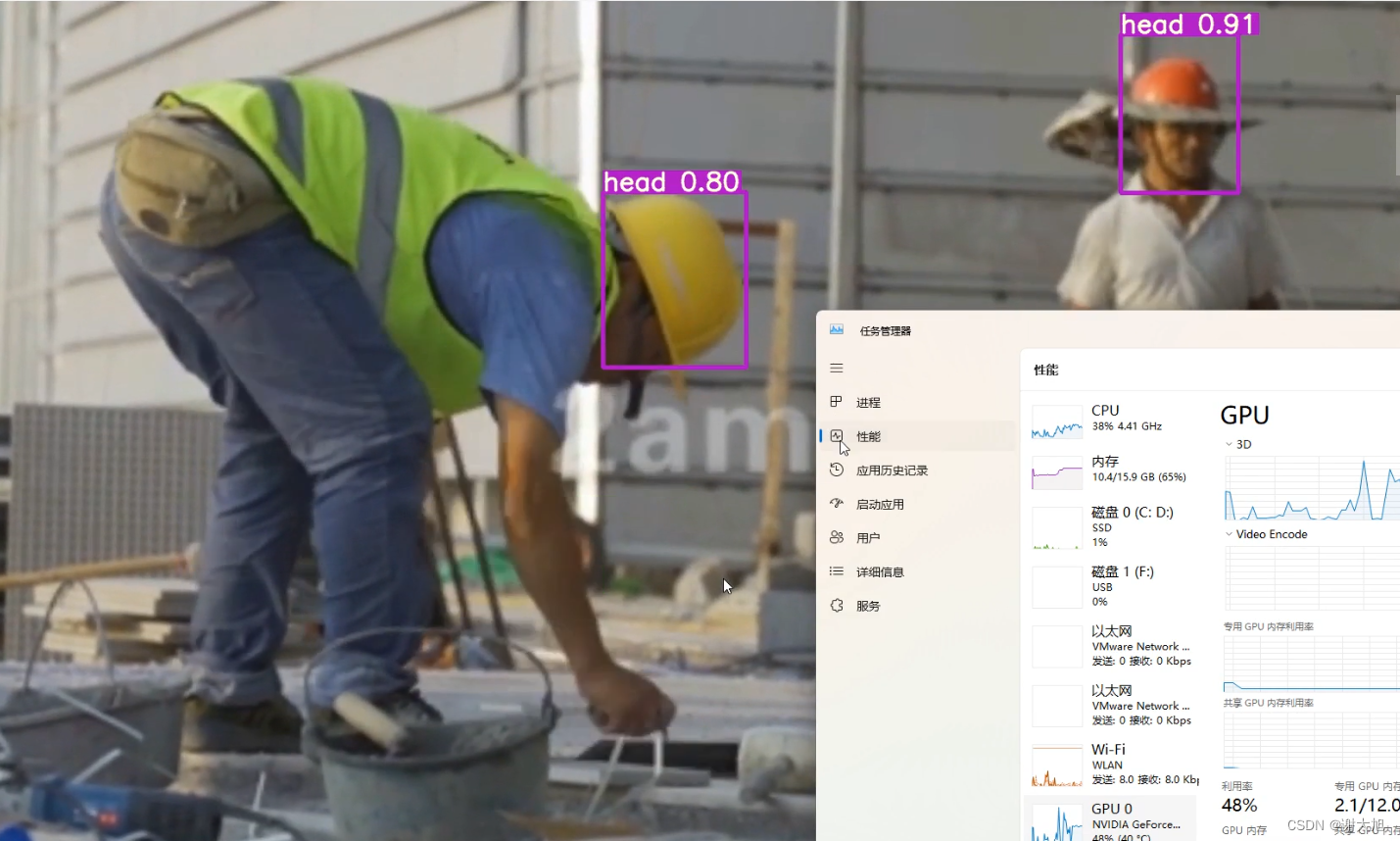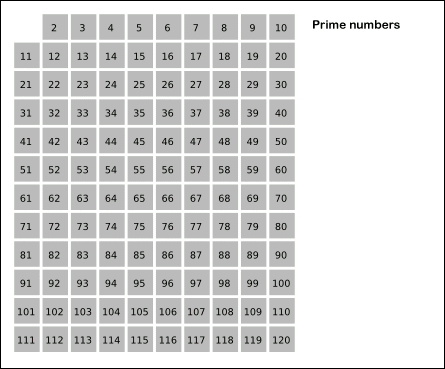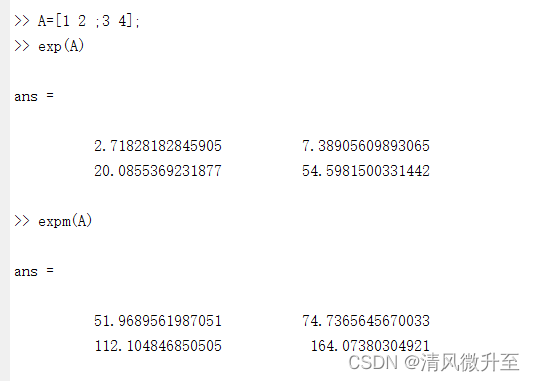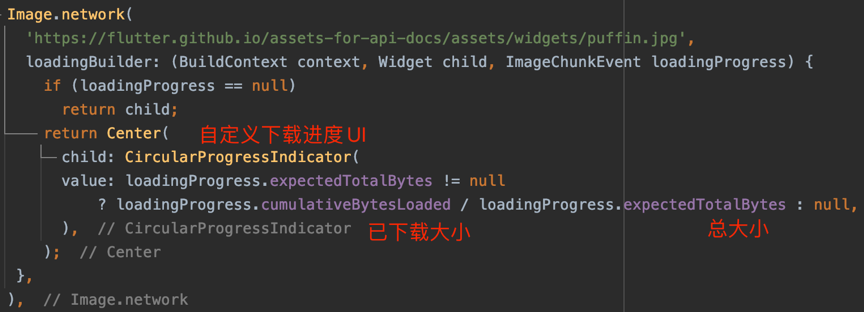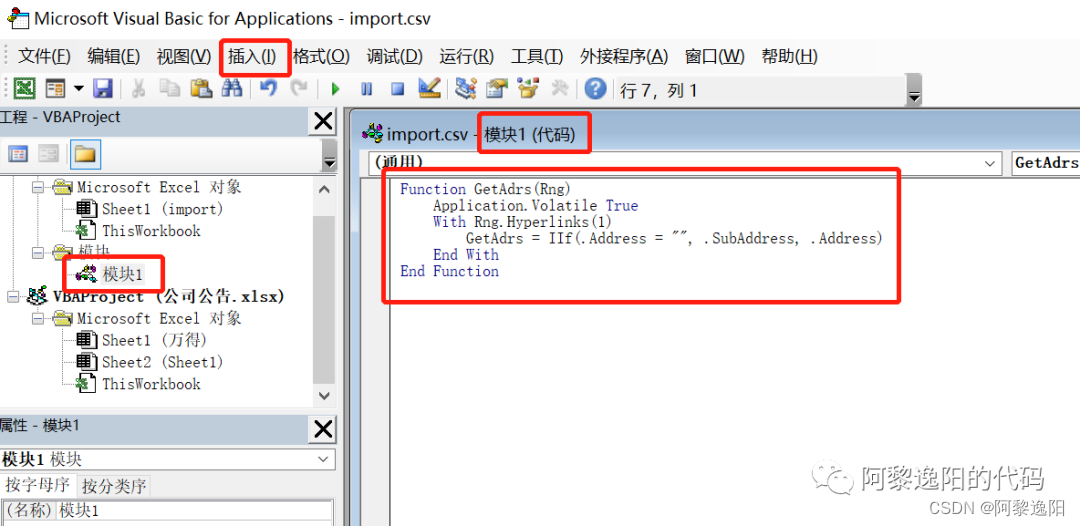目录
JZ3 数组中重复的数字
JZ4 二维数组中的查找
JZ5 替换空格
JZ6 从尾到头打印链表
JZ18 删除链表的节点
JZ22 链表中倒数最后k个结点
题目为剑指offer top100题目, 欢迎大家来学习😘
JZ3 数组中重复的数字
数组中重复的数字_牛客题霸_牛客网在一个长度为n的数组里的所有数字都在0到n-1的范围内。 数组中某些数字是重复的,但不知道。题目来自【牛客题霸】https://www.nowcoder.com/practice/6fe361ede7e54db1b84adc81d09d8524?tpId=265&tqId=39207&rp=1&ru=/exam/oj/ta&qru=/exam/oj/ta&sourceUrl=%2Fexam%2Foj%2Fta%3FtpId%3D13&difficulty=undefined&judgeStatus=undefined&tags=&title=
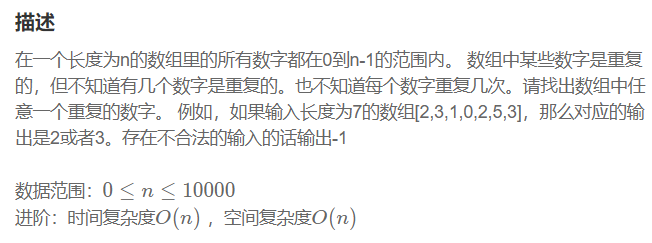

解法1: 暴力循环
也就是说, 直接开始从最左边的2开始遍历整个数组, 如果发现有重复的, 就直接返回这个数字, 如果没有重复的, 就选中下一个数字3, 然后开始遍历整个数组. 以此类推, 如果一直到数组最后一个数都没有重复的话就返回-1, 否则返回重复的数.
此方法没有使用额外的空间, 所以空间复杂度为O(1)
此方法经历了两层for循环, 每次循环的长度都为数组的长度n, 因此时间复杂度为O(n^2)
import java.util.*;
public class Solution {
/**
* 代码中的类名、方法名、参数名已经指定,请勿修改,直接返回方法规定的值即可
* @param numbers int整型一维数组
* @return int整型
*/
public int duplicate (int[] numbers) {
for(int i = 0; i < numbers.length; i++) {
int tem = numbers[i];
for(int j = i + 1; j < numbers.length; j ++) {
if (tem == numbers[j]) {
return tem;
}
}
}
return -1;
}
}解法2: 集合Set
创建一个集合对象, 从0下标开始遍历数组, 每次遍历的时候, 看这个数是否在集合中已经存在, 如果不存在就将这个数添加到集合当中, 如果这个数在集合中已经存在, 就直接返回这个数. 如果遍历完整个数组的时候, 还没有在集合中找到重复的数, 那么就返回-1.
此方法创建了一个集合, 最坏的情况下需要存储数组里面所有的元素, 因此空间复杂度为O(n)
此方法只需要遍历一次数组即可, 因此时间复杂度为O(n)
import java.util.*;
public class Solution {
/**
* 代码中的类名、方法名、参数名已经指定,请勿修改,直接返回方法规定的值即可
* @param numbers int整型一维数组
* @return int整型
*/
public int duplicate (int[] numbers) {
Set<Integer> set = new TreeSet<>();
for(int i = 0; i < numbers.length; i++) {
int tem = numbers[i];
if (set.contains(tem)) {
return tem;
}
set.add(tem);
}
return -1;
}
}解法3 : 排序和遍历
根据题目所给的数组的长度为n, 然后这个数组里面的数的取值范围又是[0, n - 1], 也就是说, 如果这个数组里面没有重复的, 那么将这个数组从小到大排序之后, 如果不存在重复的, 那么数组里面的元素大小就应该和它的下标相等, 如果不等, 则说明存在重复的.
此方法没有使用额外的空间, 因此空间复杂度为O(1)
此方法需要遍历一次集合或者是排序时间复杂度为O(n)
import java.util.*;
public class Solution {
/**
* 代码中的类名、方法名、参数名已经指定,请勿修改,直接返回方法规定的值即可
*
*
* @param numbers int整型一维数组
* @return int整型
*/
public int duplicate (int[] numbers) {
if (numbers.length == 0) {
return -1;
}
Arrays.sort((numbers));
int dele = numbers[0];
for(int i = 0; i < numbers.length; i++) {
if ((i + dele) != numbers[i]) {
return numbers[i];
}
}
return -1;
}
}JZ4 二维数组中的查找
二维数组中的查找_牛客题霸_牛客网 (nowcoder.com)![]() https://www.nowcoder.com/practice/abc3fe2ce8e146608e868a70efebf62e?tpId=265&tqId=39208&rp=1&ru=/exam/oj/ta&qru=/exam/oj/ta&sourceUrl=%2Fexam%2Foj%2Fta%3FtpId%3D13&difficulty=undefined&judgeStatus=undefined&tags=&title=
https://www.nowcoder.com/practice/abc3fe2ce8e146608e868a70efebf62e?tpId=265&tqId=39208&rp=1&ru=/exam/oj/ta&qru=/exam/oj/ta&sourceUrl=%2Fexam%2Foj%2Fta%3FtpId%3D13&difficulty=undefined&judgeStatus=undefined&tags=&title=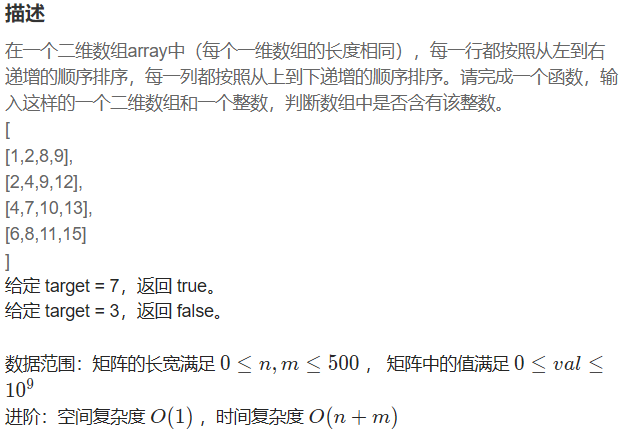

解法1 : 暴力搜索
一个很简单的方法, 就是, 把里面所有的元素全部都遍历一次, 查找里面是否存在target这个元素, 如果不存在那么就返回false, 如果存在就返回true.
由于没有用到额外的空间, 所以空间复杂度为O(1)
需要遍历整个二维数组, 所以空间复杂度为O(n * m)
此外,对于每一行, 我们除了直接从左到右进行搜索, 还可以进行二分查找, 因为每一行都是有序的.
使用二分查找:
时间复杂度:O(Mlog N ) 时间复杂度将进一步缩小
空间复杂度:O(1)
import java.util.*;
public class Solution {
/**
* 代码中的类名、方法名、参数名已经指定,请勿修改,直接返回方法规定的值即可
*
*
* @param target int整型
* @param array int整型二维数组
* @return bool布尔型
*/
public boolean Find (int target, int[][] array) {
for(int i = 0; i < array.length; i++) {
for(int j = 0; j < array[0].length; j++) {
if (target == array[i][j]) {
return true;
}
}
}
return false;
}
}解法2 : 线性搜索
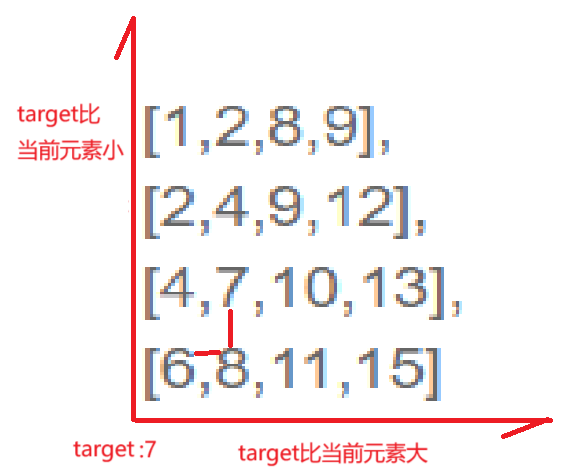
建立如图的坐标系, target放在左下角进行搜索, 如图, 假设现在target为7, 从左下角第一个元素6开始比较, target比6大, 往右一个元素继续比较, 也就是继续和8比较, 现在target = 7 比8小, 所以往上一个元素, 也就是和7进行比较, target = 7, 于是返回true. 假设target为3, 根据上图搜索, 依次比较的元素为: 6 -> 4 -> 2 -> 4 -> 2 -> 8, 比较完后, 最后遇到比较的元素的下标出了数组的边界, 也就是变成了-1的时候, 就结束比较.
- 时间复杂度:O(m+n),遍历矩阵的时候,最多经过矩阵的一行一列
- 空间复杂度:O(1),常数级变量,无额外辅助空间
import java.util.*;
public class Solution {
/**
* 代码中的类名、方法名、参数名已经指定,请勿修改,直接返回方法规定的值即可
*
*
* @param target int整型
* @param array int整型二维数组
* @return bool布尔型
*/
public boolean Find (int target, int[][] array) {
if (array[0].length == 0) {
return false;
}
// 空间复杂度o(1), 时间复杂度O(m + n)
int x = 0;
int y = array.length - 1;
while (x != array[0].length && y != -1) {
int now = array[y][x];
if (target > now) {
x++;
} else if (target < now) {
y--;
} else {
return true;
}
}
return false;
}
}JZ5 替换空格
替换空格_牛客题霸_牛客网 (nowcoder.com)![]() https://www.nowcoder.com/practice/0e26e5551f2b489b9f58bc83aa4b6c68?tpId=265&tqId=39209&rp=1&ru=/exam/oj/ta&qru=/exam/oj/ta&sourceUrl=%2Fexam%2Foj%2Fta%3FtpId%3D13&difficulty=undefined&judgeStatus=undefined&tags=&title=
https://www.nowcoder.com/practice/0e26e5551f2b489b9f58bc83aa4b6c68?tpId=265&tqId=39209&rp=1&ru=/exam/oj/ta&qru=/exam/oj/ta&sourceUrl=%2Fexam%2Foj%2Fta%3FtpId%3D13&difficulty=undefined&judgeStatus=undefined&tags=&title=
依次遍历字符串, 从字符串的第一个字符开始, 然后新建一个StringBuilder sb, 如果遍历的字符不是空格则直接将其添加到sb中, 如果是空格, 就添加 %20 到sb中去. 然后返回sb.toString();
- 时间复杂度O(n)
- 空间复杂度O(n)
import java.util.*;
public class Solution {
/**
* 代码中的类名、方法名、参数名已经指定,请勿修改,直接返回方法规定的值即可
*
*
* @param s string字符串
* @return string字符串
*/
public String replaceSpace (String s) {
StringBuilder sb = new StringBuilder();
for (int i = 0; i < s.length(); i++) {
if (s.charAt(i) == ' ') {
sb.append("%20");
} else {
sb.append(s.charAt(i));
}
}
return sb.toString();
}
}JZ6 从尾到头打印链表
从尾到头打印链表_牛客题霸_牛客网 (nowcoder.com)![]() https://www.nowcoder.com/practice/d0267f7f55b3412ba93bd35cfa8e8035?tpId=265&tqId=39210&rp=1&ru=/exam/oj/ta&qru=/exam/oj/ta&sourceUrl=%2Fexam%2Foj%2Fta%3FtpId%3D13&difficulty=undefined&judgeStatus=undefined&tags=&title=
https://www.nowcoder.com/practice/d0267f7f55b3412ba93bd35cfa8e8035?tpId=265&tqId=39210&rp=1&ru=/exam/oj/ta&qru=/exam/oj/ta&sourceUrl=%2Fexam%2Foj%2Fta%3FtpId%3D13&difficulty=undefined&judgeStatus=undefined&tags=&title=
方法一: 使用数组来记录链表里面所有的元素, 然后新建一个链表, 将数组里面的元素反向添加到新建的链表中去.
- 空间复杂度为O(n)
- 时间复杂度为O(n)
import java.util.*;
/**
* public class ListNode {
* int val;
* ListNode next = null;
*
* ListNode(int val) {
* this.val = val;
* }
* }
*
*/
import java.util.ArrayList;
public class Solution {
public ArrayList<Integer> printListFromTailToHead(ListNode listNode) {
int[] arr = new int[10000];
int size = 0;
ListNode tem = listNode;
while (tem != null) {
arr[size++] = tem.val;
tem = tem.next;
}
ArrayList<Integer> list = new ArrayList<>();
for(int i = size - 1; i >= 0; i--) {
list.add(arr[i]);
}
return list;
}
}
方法二: 使用堆栈, 其实总体上的思想其实和方法一差不多的, 只是换了一个形式.
- 时间复杂度为O(n)
- 空间复杂度为O(n)
import java.util.*;
/**
* public class ListNode {
* int val;
* ListNode next = null;
*
* ListNode(int val) {
* this.val = val;
* }
* }
*
*/
import java.util.ArrayList;
public class Solution {
public ArrayList<Integer> printListFromTailToHead(ListNode listNode) {
Stack<Integer> stack = new Stack<>();
ListNode tem = listNode;
while (tem != null) {
stack.push(tem.val);
tem = tem.next;
}
ArrayList<Integer> list = new ArrayList<>();
while (!stack.isEmpty()) {
int topElement = stack.pop();
list.add(topElement);
}
return list;
}
}
方法三: 递归, 既然我们正向不能直接得出结果, 那我们就可以使用递归, 先将标记结点递归到最后一位, 然后从最后一位开始反方向遍历元素:
- 时间复杂度为O(n)
- 空间复杂度为O(n)
import java.util.*;
/**
* public class ListNode {
* int val;
* ListNode next = null;
*
* ListNode(int val) {
* this.val = val;
* }
* }
*
*/
import java.util.ArrayList;
public class Solution {
public ArrayList<Integer> printListFromTailToHead(ListNode listNode) {
ArrayList<Integer> list = new ArrayList<>();
function(list, listNode);
return list;
}
public static void function(ArrayList<Integer> list, ListNode node) {
if (node == null) {
return;
}
function(list, node.next);
list.add(node.val);
}
}
JZ18 删除链表的节点
删除链表的节点_牛客题霸_牛客网 (nowcoder.com)![]() https://www.nowcoder.com/practice/f9f78ca89ad643c99701a7142bd59f5d?tpId=265&tqId=39280&rp=1&ru=/exam/oj/ta&qru=/exam/oj/ta&sourceUrl=%2Fexam%2Foj%2Fta%3FtpId%3D13&difficulty=undefined&judgeStatus=undefined&tags=&title=
https://www.nowcoder.com/practice/f9f78ca89ad643c99701a7142bd59f5d?tpId=265&tqId=39280&rp=1&ru=/exam/oj/ta&qru=/exam/oj/ta&sourceUrl=%2Fexam%2Foj%2Fta%3FtpId%3D13&difficulty=undefined&judgeStatus=undefined&tags=&title=
这题比较简单, 我们直接使用遍历 然后删除结点即可, 也就是使用双指针的形式, 一个指针用来记录后面的结点, 方式丢失, 一个指针用来连接记录结点. 但是要注意空指针的问题. 以及元素比较少的时候该怎么判断.
- 时间复杂度O(n)
- 空间复杂度O(1)
import java.util.*;
/*
* public class ListNode {
* int val;
* ListNode next = null;
* public ListNode(int val) {
* this.val = val;
* }
* }
*/
public class Solution {
/**
* 代码中的类名、方法名、参数名已经指定,请勿修改,直接返回方法规定的值即可
*
*
* @param head ListNode类
* @param val int整型
* @return ListNode类
*/
public ListNode deleteNode (ListNode head, int val) {
ListNode l = head;
ListNode r = head.next;
if (l.val == val) {
return head.next;
}
while (r != null) {
if (r.val == val) {
l.next = r.next;
break;
}
r = r.next;
l = l.next;
}
return head;
}
}JZ22 链表中倒数最后k个结点
链表中倒数最后k个结点_牛客题霸_牛客网 (nowcoder.com)![]() https://www.nowcoder.com/practice/886370fe658f41b498d40fb34ae76ff9?tpId=265&tqId=39224&rp=1&ru=/exam/oj/ta&qru=/exam/oj/ta&sourceUrl=%2Fexam%2Foj%2Fta%3FtpId%3D13&difficulty=undefined&judgeStatus=undefined&tags=&title=
https://www.nowcoder.com/practice/886370fe658f41b498d40fb34ae76ff9?tpId=265&tqId=39224&rp=1&ru=/exam/oj/ta&qru=/exam/oj/ta&sourceUrl=%2Fexam%2Foj%2Fta%3FtpId%3D13&difficulty=undefined&judgeStatus=undefined&tags=&title= 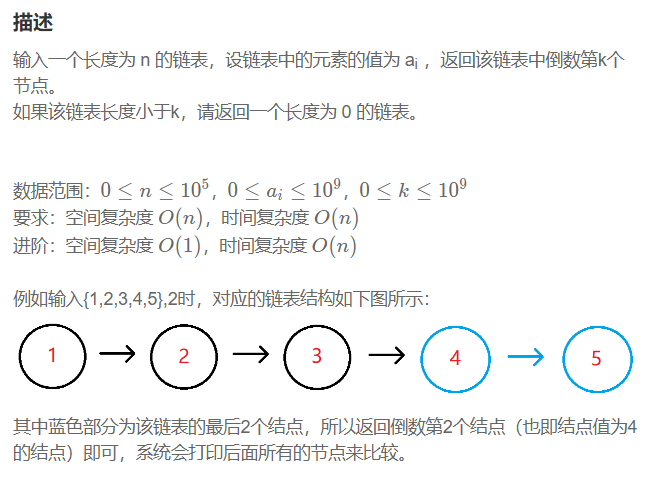

方法一: 直接遍历, 利用性质, 先遍历出链表里面所有的元素的总个数, 然后再计算出需要走的步数,

import java.util.*;
/*
* public class ListNode {
* int val;
* ListNode next = null;
* public ListNode(int val) {
* this.val = val;
* }
* }
*/
public class Solution {
/**
* 代码中的类名、方法名、参数名已经指定,请勿修改,直接返回方法规定的值即可
*
*
* @param pHead ListNode类
* @param k int整型
* @return ListNode类
*/
public ListNode FindKthToTail (ListNode pHead, int k) {
int size = 0;
ListNode tem = pHead;
while (tem != null) {
size ++;
tem = tem.next;
}
if (size < k) {
return null;
}
for(int i = 0; i < size - k; i++) {
pHead = pHead.next;
}
return pHead;
}
}方法二: 快慢指针, 一个快一个慢:

import java.util.*;
/*
* public class ListNode {
* int val;
* ListNode next = null;
* public ListNode(int val) {
* this.val = val;
* }
* }
*/
public class Solution {
/**
* 代码中的类名、方法名、参数名已经指定,请勿修改,直接返回方法规定的值即可
*
*
* @param pHead ListNode类
* @param k int整型
* @return ListNode类
*/
public ListNode FindKthToTail (ListNode pHead, int k) {
ListNode slow = pHead;
ListNode fast = pHead;
if (slow == null) {
return null;
}
for(int i = 0; i < k; i++) {
fast = fast.next;
if (i != k - 1 && fast == null) {
return null;
}
}
while (fast != null) {
slow = slow.next;
fast = fast.next;
}
return slow;
}
}方法三 : 使用堆栈, 将所有的结点, 从pHead开始, 全部压入栈中, 然后取出第k个结点, 就是倒数第k个结点了:
import java.util.*;
/*
* public class ListNode {
* int val;
* ListNode next = null;
* public ListNode(int val) {
* this.val = val;
* }
* }
*/
public class Solution {
/**
* 代码中的类名、方法名、参数名已经指定,请勿修改,直接返回方法规定的值即可
*
*
* @param pHead ListNode类
* @param k int整型
* @return ListNode类
*/
public ListNode FindKthToTail (ListNode pHead, int k) {
// write code here
Stack<ListNode> stack = new Stack<>();
while (pHead != null) {
stack.push(pHead);
pHead = pHead.next;
}
if (stack.isEmpty()) {
return null;
}
ListNode result = null;
for(int i = 0; i < k; i++) {
result = stack.pop();
if (i != k - 1 && stack.isEmpty()) {
return null;
}
}
return result;
}
}




